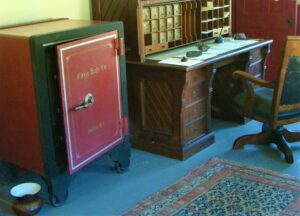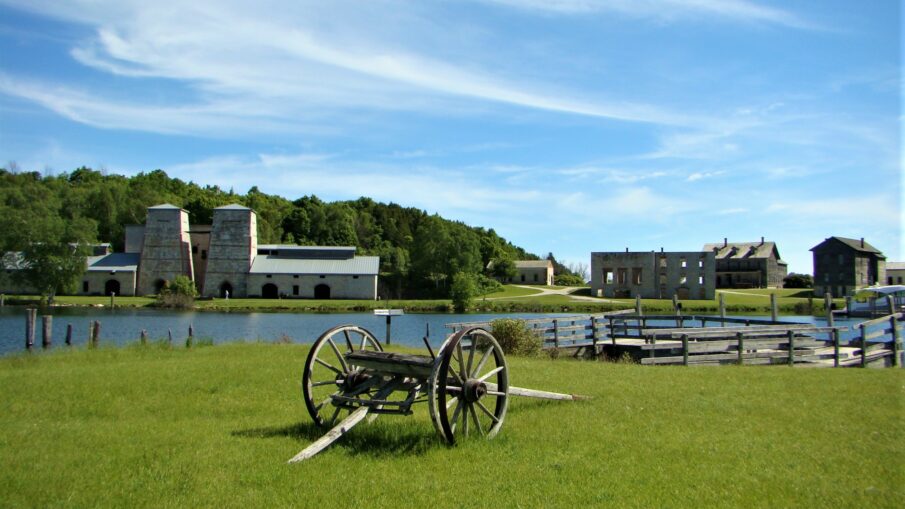Ghost towns only are found in the Old West, right?
This surprising travel find appears in Michigan, at an idle but once booming company town.
Fayette State Historic Park is an excellent preservation of what was once a working city of more than 1,000 people.
One-time park historian Thomas Friggens would quarrel with the notion that this is a true “Ghost Town.” He told the Detroit Free Press this site never was fully uninhabited.
But abandoned buildings and furnaces were in full-scale decay between 1940-59, when ownership of the property changed hands a number of times. Finally, in 1959, the state purchased the Fayette town site and began a restoration process that you can enjoy today. It is now a Michigan State Park, with the official name Fayette Historic State Park and Harbor.
Why did Fayette exist in the first place?
The site overlooks the Lake Michigan shoreline on the state’s Upper Peninsula (UP), not far from where iron ore was mined in large quantities during the 19th century.
This iron ore needed to be shipped to the steel-making cities at the southern end of the Great Lakes, but there was a problem. The raw ore contained waste product that added 40 percent to the shipping weight. Talk about inefficiency!
So the Jackson Iron Company decided to establish a smelting operation that was close to the mines but also right on the lake. Using a technique in blast furnaces that separated waste from iron, the purified product formed into 100-150 lb. ingots ready to ship. These ingots were nicknamed “pigs,” and the product leaving Fayette was called pig iron.
Company executives chose a location on the UP’s Garden Peninsula where a scenic and sheltered natural harbor was present.  They named the town Fayette, in honor of Fayette Brown, the company agent who selected the site.
They named the town Fayette, in honor of Fayette Brown, the company agent who selected the site.
Fayette was a busy place from 1867-1890. According to signage at the site, Fayette turned out nearly 230,000 tons of product during its productive years. Nearby timber was harvested to fuel the fires, and limestone from Lake Michigan bluffs was added to purify the iron ore. The website ExploringTheNorth says workers came here from Canada and northern Europe to work in this company town. As was typical of such places, the company owned everything and therefore became a universal vendor of room, board and supplies. You can see a restored version of the paymaster’s office.
By the end of 1890, the market for Fayette’s pig iron had declined sharply. Fayette had a hotel, boarding houses for families, a machine shop, a company store, and even an Opera House. The most imposing buildings in town housed the two huge furnaces. All of this has been restored to a look historians believe is identical to the late 19th century. The work included mixing only paint colors that would have been available in those days. Signage throughout explains the workings of each building. In some cases, you see only rock foundations for what was once someone’s home.
 Many visitors simply wander the grounds and read the signage. In addition, scheduled tours are conducted from mid-June through Labor Day, and the area celebrates Fayette Heritage Days the second Saturday in August. You’ll see special displays during this time, with food and music that would have been typical in Fayette.
Many visitors simply wander the grounds and read the signage. In addition, scheduled tours are conducted from mid-June through Labor Day, and the area celebrates Fayette Heritage Days the second Saturday in August. You’ll see special displays during this time, with food and music that would have been typical in Fayette.
Bring your camera. In addition to the educational aspects of Fayette, you’ll be surrounded with scenic views. Snail Shell Harbor sports limestone cliffs and crystal-clear water, making it a great place to take pictures. No wonder this area was operated as a vacation resort for part of its history.
Because this area sees harsh winter conditions, the town site is only open from mid-May to mid-October. Boat slips and a few campsites are available about the same time. The larger state park remains open all year.
It takes a bit of effort to find Fayette, as it’s about 17 miles south of U.S. 2, the main east-west route in the UP. Take Delta County Road 183, a turnoff found along US-2 just west of Manistique and east of Escanaba. Your effort will be rewarded with a unique look at a bygone era — and you’ll be discovering a hidden gem unknown even to many a well-traveled Michigander.
If You Go

